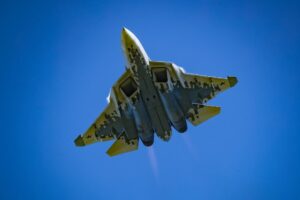 |
| Su-57 |
The Pentagon has withdrawn its application for the F-35 to participate in the flight program of the Aero India 2025 international airshow in India in response to the recent accident of an American fifth-generation fighter. Instead, the aircraft will serve as a static exhibit.
This helps Russia’s Su-57 to showcase its capabilities to potential buyers without facing competition from the F-35. Sukhoi develops and manufactures the Su-57 at the Komsomolsk-on-Amur Aviation Plant (KnAAZ). It is a fifth-generation multirole fighter that is engineered to penetrate air defense systems and defeat enemy ground and surface targets while engaging in long-range and close-range combat, as well as to destroy all types of air targets.
Rosoboronexport has announced the signing of the initial contracts for the export of fifth-generation Su-57 fighters in November 2024.
“The military-technical cooperation system must bring new weapons and military equipment to the market. As for the Su-57, we already have the first signed contracts for this aircraft,” said the company’s head, Alexander Mikheev, in an interview with the “Russia-1” TV channel (VGTRK).
The company did not specify the client, and it is probably Algeria.
The advanced Russian fifth-generation fighter Su-57E, the export variant, could have slight differences from the version that is supplied to the Russian Aerospace Forces in its export version. These aircraft might lack systems for identifying friends or foes (IFF) or directing nuclear weapons. Additionally, there may be variations in radar and radio-technical equipment.
If India were to import fifth-generation fighters, the Russian Su-57E and Su-75 Checkmate could serve as the primary competitors to the American F-35. Currently, the nation is in the process of developing its own fifth-generation stealth fighter. Pakistan’s reported acquisition of the Chinese J-35 aircraft could potentially alter India’s future plans.
In the past, India had abandoned the proposal to jointly develop the Su-57 and was skeptical about the fifth-generation engine. According to Russian officials, the Su-57E, which is equipped with the most recent Izdelie 30 or AL-51F engine and 2D Thrust Vector Control (TVC) nozzles, is at least 4–5 years away.
At the same time, Russia has been unable to produce an adequate number of aircraft for its own use. Consequently, how will it manage foreign deliveries? As of late 2024, it had only delivered 22 Su-57 aircraft, including both production and test variants. The Kremlin had established an ambitious objective of acquiring 76 Su-57s by 2028. The primary production site for the Su-57, the Komsomolsk-on-Amur factory, has encountered issues with capacity. Despite the establishment of new facilities to improve production capabilities, experts suggest that the factory has only delivered approximately one-third of the scheduled aircraft under existing contracts.
Sergey Chemezov, CEO of Rostec Corporation, stated on the 15th anniversary of the Su-57’s inaugural flight that the Russian fifth-generation fighter will be more actively promoted in the international market by increasing the production capacity of the United Aircraft Corporation (UAC).
Rostec cited him as stating, “The expansion of UAC’s production capacity will allow for increased deliveries of the fighter to the armed forces, as well as actively offering the Su-57 in its export version to foreign customers.”
There are hints that Russia may propose a Government-to-Government (G2G) agreement that incorporates the possibility of co-manufacturing the Su-57 as part of India’s self-manufacturing initiative. This is consistent with India’s strategic objective of improving its defense production capabilities, which has been a primary focus of the Indian government.
Vietnam is also one of the nations that has expressed a strong interest in acquiring the Su-57 stealth fighter aircraft from Russia. The potential procurement discussions between Russia and Vietnam could be facilitated by the growing defense ties between the two countries, which would make Vietnam a probable candidate for the first foreign purchase of this advanced aircraft. According to reports, Vietnam may pursue the acquisition of 12 to 24 Su-57s, with an estimated contract value of approximately $2 billion. Vietnam’s fleet is aging, and this procurement would modernize it in response to the growing military pressures in the South China Sea.
In addition to Vietnam, Turkey has also emerged as a potential buyer of the Su-57. Turkey’s involvement is indicative of its ongoing attempts to improve its air combat capabilities and diversify its military procurement sources. The Su-57 is a compelling alternative that is consistent with Turkey’s strategic objectives as it attempts to modernize its air force and strengthen its defense industry. The broader appeal of Russia’s fifth-generation fighter aircraft in the international arms market is underscored by the interest from both Vietnam and Turkey, as a variety of nations examine ways to enhance their military capabilities in the face of changing geopolitical landscapes.
Official Website of Youtube Channel – Altitude Addicts

